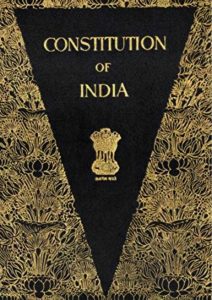Characteristics/Features Of The Indian Constitution: The constitution of a state is a set of basic principles that govern the behavior of its citizens. In India, the constitution is the supreme law of the nation; it creates the rule of law and provides political stability to the country. India’s constitution has been drafted and enacted. It arose from a number of Acts enacted during the British period. The Constituent Assembly enacts and prepares it.
The cabinet mission plan dictated the composition of the Constituent Assembly. India’s Constitution is a one-of-a-kind document. It is the world’s most comprehensive liberal democratic constitution. It combines federalism with Unitarianism, as well as flexibility and rigidity. The Indian Constitution has effectively guided the country’s path and prosperity from its inception on January 26, 1950. Every organization follows a set of basic guidelines. The constitution describes the state’s core regulations.

Everyone should be aware of the constitution as an Indian citizen and a student of political science. It transforms students become well-informed citizens. The Constituent Assembly is responsible for India’s constitution. The provincial legislative assemblies were to elect their delegates to the constituent Assembly, according to the Cabinet Mission Plan. The work was finished in two years, eleven months, and eighteen days by the constituent Assembly. India’s constitution took effect on January 26, 1950.
As a result, the 26th of January is observed as Republic Day.

Recommended: Richest lawyers in India 2024
Major Features/Characteristics of The Indian Constitution
1. The world’s longest constitution: The Indian constitution, which was approved by the Constituent Assembly on November 2, 1949, is the world’s longest, with 395 articles grouped into 22 sections and nine schedules. It’s referred to as having an ‘elephant-sized’ constitution. In January 2003, we ratified 93 amendments to the constitution. For many developing nations, it has served as a model. There are currently 397 articles and 12 schedules. Several things contribute to the constitution’s length:
It draws on the experience of all of the world’s most powerful constitutions.
It establishes a constitution for both the union and the states.
It contains specific regulations about the relationship between the center and the states.
It has specific provisions for Jammu and Kashmir.
It covers both defensible and unjustifiable rights.
It has unique provisions to address regional issues.
Recommended: Major Challenges faced by Youths Today
2. The people have sovereignty: The constitution of India was established and enacted by the people of India, and they are the republic’s caretakers, according to the preface.
3. India’s constitution mandates a parliamentary system of governance at both the national and state levels: Under a Parliamentary system, the Prime Minister and the Council of Ministers are accountable to the government, especially the Lower House, Lok Sabha. Questioning, no-confidence resolutions, and other measures are used by Parliament to exert influence over the executive branch. In the Parliamentary system, there are two types of heads: nominal and actual. The President of India is only a ceremonial figurehead; the Prime Minister is the genuine leader of India.
Also see: Highest Paying Jobs In India and their Salary 2024: Top 10
4. Rigidity and Flexibility in a One-of-a-Kind Design: Despite the fact that India has a written constitution, it is not as strict as the American one. The processes for amending the contract have been made more flexible. The constitution can be modified using three different techniques. Amending a document is a straightforward task.
5. Part III of the constitution guarantees all people fundamental rights: It protects the rights to equality, freedom, and religion, as well as the rights to protection from exploitation, education, and cultural rights. It also protects the right to constitutional remedies. In the event of a breach of fundamental rights, the Supreme Court can be approached immediately. Fundamental rights are restricted in the interests of public order, India’s sovereignty and integrity, public decency, morality, and other considerations.
6. The State Policy Directive Principles: Economic and Cultural Rights are covered in Part IV of the constitution. They are, nevertheless, unjustifiable in a court of law. Our constitution’s vision of a “welfare state” can only be realized if governments strive to execute it with a strong sense of moral obligation.
Also see: Cheapest Places To Live in India 2024: Top 10 Most Affordable
7. Quasi–federal in nature: The Indian state is quasi-federal in character, in the sense that powers are shared between the Union and the state. In times of emergency, however, the government takes on a more unified form. It is federal because:
It has two sets of government.
Between the center and the states, there is a separation of powers.
There is a separate judiciary system.
It is unitary because:
There is a single nationality.
There is a unified judicial and administrative system that is integrated.
Elections and audits are handled by integrated equipment.
The President appoints and removes state governors, and states rely on the federal grant–in–aid.
It is described as a “union of states”.
It may be changed to a unitary system in an emergency.
8. Adult Suffrage: The right to vote is granted to all adults over the age of 18. There are no distinct electorates for persons from various ethnic groups. As a result, in India, Universal Adult Franchise exists without Communal Representation.
9. The judiciary is independent: Thanks to the constitution, the judiciary is immune from interference from other government organs, allowing them to make decisions without fear or favor. According to the separation of powers principles, the Indian judiciary is autonomous. The element that goes with the independence of the judiciary is that judges are appointed directly by the President and are paid well. Judges cannot be dismissed by the government alone.
10. Judicial Review: It refers to the courts’ ability to declare invalid any law approved by the legislature or any executive conduct that breaches any article of the constitution. It underlines the judiciary’s supremacy.
Also see: Countries With the Best Doctors in the World 2024 : Top 11
11. Fundamental Responsibilities: The 42nd amendment incorporates the Fundamental Duties into the Constitution. Article 51 establishes a set of 10 essential responsibilities.
12. Sovereignty: India is a sovereign and independent nation. India is no longer under the control of any foreign power, and no external force can sway its actions. India belongs to the Commonwealth of Nations. However, India’s sovereignty is unaffected by its membership.
13. Basic Administration Uniformity: In the majority of administrative concerns, there is consistency. For example, a unified court system, consistent civil and criminal legislation, and all-India services.
14. Revolutionary: The Indian constitution has banned various unfair practices while also providing specific chances for the upliftment of the disadvantaged sectors of society.
Also see: Best Countries To Study MBA
15. A lawyer’s dream come true: The Indian constitution is difficult to comprehend for the average person. Litigation and constitutional changes are the results of the intricacy. This elevates the status of lawyers.
16. Democracy: India has a government that is democratically elected and accountable. The purpose of democracy was to achieve political, economic, and social democracy.
17. Republic: It implies that, as the state’s main executive, the president will be chosen by the people on a regular basis. Citizens’ participation in governmental matters is ensured.
Also see: Top 10 Countries with the best education system in the world
18. Secular: The constitution of India establishes a secular government. It shows that the state equally protects all religions.
No religion is recognized as the official religion by the state.
The right to religious freedom is established in the constitution.
All religions are treated the same way.
19. As a single individual, you can obtain single citizenship: The Indian constitution provides for single Indian citizenship. This contributes to the development of a sense of oneness.
Recommended: Highest paying companies in the world
Conclusion
India’s constitution is one of the world’s most outstanding constitutions. It is a meeting point between East and West. With all of these characteristics, the Indian Constitution is the most appropriate constitution for the Indian context. In both peace and conflict, the Constitution has aided India in effectively organizing and running its government and administration. Preamble, Fundamental Rights, Directive Principles, Secularism, Federalism, Republicanism, Judiciary Independence, Rule of Law, and Liberal Democracy are the core framework and most fundamental characteristics of the Constitution.

Edeh Samuel Chukwuemeka, ACMC, is a lawyer and a certified mediator/conciliator in Nigeria. He is also a developer with knowledge in various programming languages. Samuel is determined to leverage his skills in technology, SEO, and legal practice to revolutionize the legal profession worldwide by creating web and mobile applications that simplify legal research. Sam is also passionate about educating and providing valuable information to people.